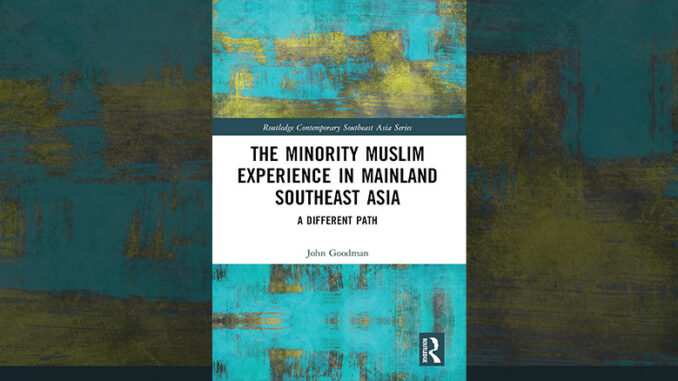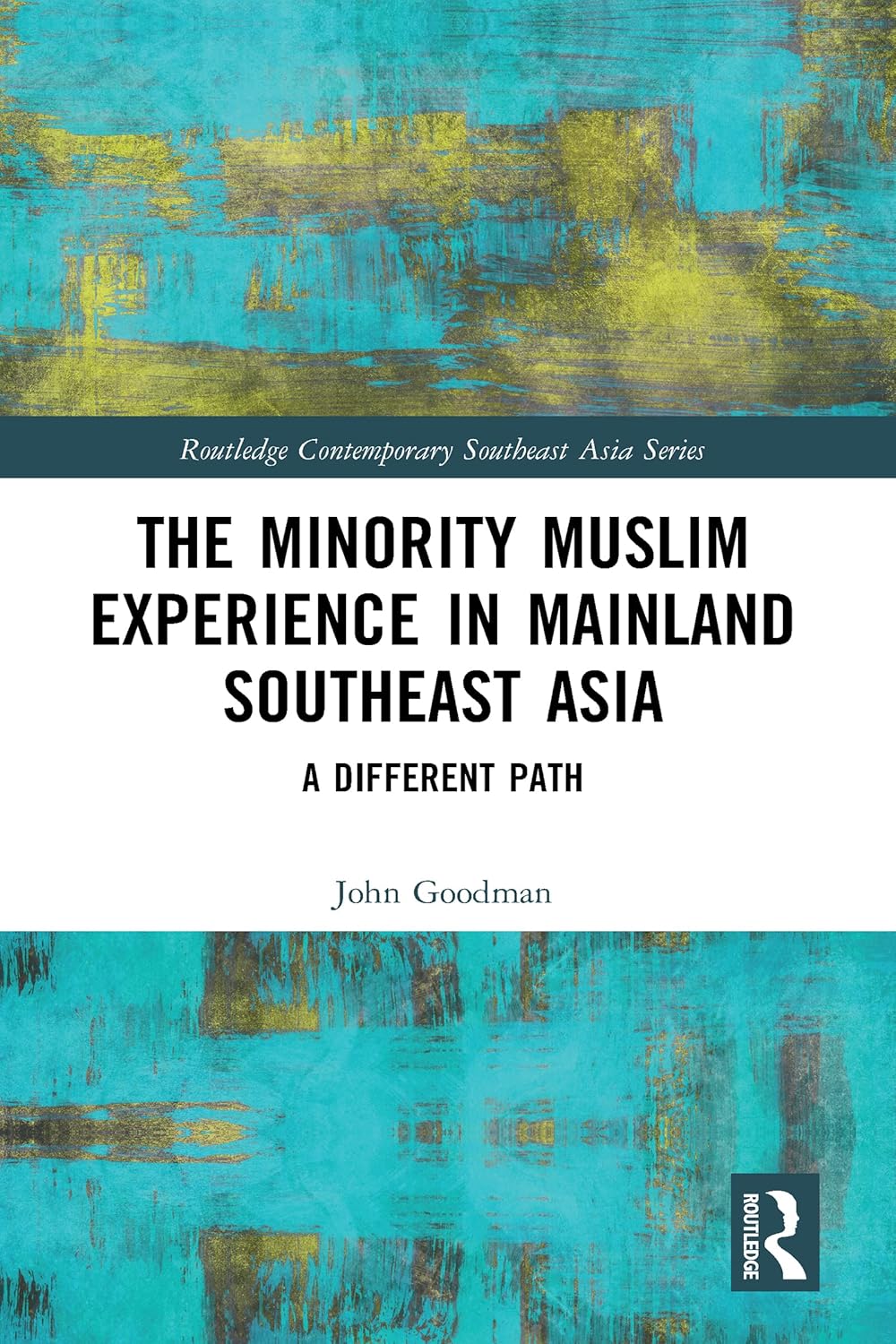
Title: The Minority Muslim Experience in Mainland Southeast Asia: A Different Path
Author: John Goodman
Publisher: (Routledge Contemporary Southeast Asia Series) 1st Edition, 2021
As is properly mentioned by the author, when people think about Islam in Southeast Asia, “they tend to focus on the majority Muslim centres of Indonesia and Malaysia”. Not much attention has been given to the Muslim minorities in other non-Muslim countries, especially those Muslims in the countries on the mainland Southeast Asia. Research on these Muslim minorities are rather sporadic. The Malay Muslims in the southern border provinces of Thailand might be an exception. However numerous research on the Muslims from this region, either in English, Thai or Malay, are mainly concerned about the conflict which erupted at the beginning of 2004 and still continues to this day.
For this reason, this book is valuable as a very rare comparative study of Muslim minorities in non-Muslim Southeast Asian countries, touching upon various dimensions related to these minorities such as histories, politics, economy, education and influence of social media. Due to the fact that the dimensions of the three minority Muslims from three different countries dealt with in this book are so various, as a consequence the analyses on these topics are not in depth. Still the less, this book can be read as a comprehensive ‘guidebook’ for those who want to approach the ethnic Muslim minorities from Thailand (Malay Muslims), Cambodia and Vietnam (Cham Muslims) and obtain overall pictures of their society.
The Malay Muslims in the southernmost province of Thailand is covered best in this book, probably because of the richness of the references and accessibility to the informants. Although the conflict still continues, this region (known as Patani) has been regularly visited researchers both from inside country and overseas. Apart from the lack of security guarantees, there are hardly any serious obstacles for researchers to conduct an extensive research here. Research into the Cham society in Cambodia is more challenging as their population is relatively scattered, not concentrated in one part of the country like the Malay Muslim counterpart in Thailand. The author faced the heaviest challenge in Vietnam, where every interview of the informants must be accompanied by local police officers, a research environment hardly conducive for an in-depth, semi-structured interview in order to listen to their real political perception. Even under such restrictions, the author has successfully demonstrated similarities between the collective strategies adopted by these Muslim minorities through their experiences of negotiating their survival in the highly challenging environments, even though there are plenty of differences among them.
It is significant to remind that all the Muslim minorities researched in this book are all ‘original settlers’ of their regions, unlike misunderstandings of some people. The colloquial term ‘khaek’, used by Thais to refer to Muslims in Thai, is notoriously confusing. This term is seen as derogative by Muslims (and they are resentful against it every time the term is used to call them), because it literally means a ‘guest’ or ‘alien’. Ayutthaya had never been successful to subjugate Patani (though Patani became a vassal state of it), and it was only after the establishment of Siam when Patani was finally annexed as a part of the country. Chams were migrants from their home country which had been defeated by Vietnamese. But their existence in their regions is far longer than the establishment of the modern nation states. For this matter, the author properly explained that “the borders and nations of Southeast Asia came into place long after the populations had settled in their current places. The nation ‘landed on’ them, not the revers.” (p. 18)
This being ethnic-religious-linguistic minority is the core of so many problems faced by them, as these are “three factors that are most significant when it comes to pressures for conformity within a nation-state” (p. 158). In highly authoritarian countries upholding the national ideologies (centering upon Buddhism in Thailand and Cambodia, and communism in Vietnam), these Muslim minorities are certainly “in” their host countries respectively but probably not “of” it (p. 160). This difficult position of the ethnic Muslim minorities becomes even more obvious when compared with that of other non-Malay or assimilated Muslims, especially in Thailand. Although their religion, Islam, is not the main religion of the country, they face far fewer problems in terms of their relationship with the state compared to their Malay brethren.

The Malay Muslims in Thailand are geographically concentrated in three southern border provinces of Pattani, Yala and Narathiwat (approximately in accordance with the territory of the former sultanate of Patani). At the same time, Muslims in some places outside this region, especially in Bangkok and its vicinities are descendant of war prisoners brought to these regions after Patani was defeated by Siam. Satun provinces used to be a part of Kedah in the past, and at least some part of Muslims in the upper south provinces were taken from Kedah (and some villages, though the number is declining, still use a dialect of Malay akin to that of Kedah). The author tends to treat them as Muslims of Thai ethnicity, but this is highly arguable. These Muslims outside the southern border provinces of Thailand are originally ethnic Malays. However, caused by several factors, they have been well assimilated into the Thai society, gradually discarding their own identities, especially the ability to speak Malay.
Therefore, the Muslim minorities in Thailand are not merely the matter of juxtaposition of Malay Muslims and (ethnically) Thai Muslims. The Malay Muslims in the southern border provinces of Pattani, Yala and Narathiwat form a regional majority (approximately 80 percent of the population are Muslims), whereas Muslims in Satun also hold the similar status as the regional majority of the province with the similar percentage, but most of them are assimilated and integrated into the mainstream Thai society. This is one of the reasons why there have been no violent incident staged in this province, while the conflict continues in the other southern border provinces. Muslims in other provinces of the southern part are, although their number is not small, all minority groups at the provincial level. Therefore, more nuanced observation shows that the difficulties faced by the Muslim minorities in Thailand are not caused by their Islamic belief, but their allegiance to the Malay ethnicity.
In fact, the circumstances surrounding the Muslim communities have much improved in the three countries discussed in this book (p.170). These states take different positions toward their Muslim minorities from those of such countries as Myanmar or Sri Lanka (the author could not include Rohingya Muslims due to the extreme difficulties to access the resources in Myanmar). Some cases of Islamophobia are presented in this book, but interestingly “the greater level of authoritarian control” is exerted by these governments in order “to suppress and restrict alternative narratives of anti-Islamic populism, which is seen as a potential threat to state control” (p. 179). An outstanding example is an ultra-nationalistic monk who posted on social media that “It is time to arm Thai Buddhists … time for compassion has run out. If a monk is killed in the deep south (the southern border provinces), a mosque must be burned down in exchange. Starting from the north, we must chase away this cult from every area until there is no one from the cult left.” (p143). Importantly, before the influence of such hate speeches became serious, “he was harshly reprimanded (by the authorities), and after continuing to post anti-Muslim material was arrested by the army, who described him as ‘threat to national security’ and then handed over to his home wat (temple), where he was defrocked in 2017” (p. 143).
Such an attitude of the governments should not be interpreted as the political will of these governments to promote multiculturalism. As is explained by the author in p. 175, when they claim to a belief in multiculturalism, “they are referring to the fact that they are aware of the existence of minorities within their borders”. In other words, the policies of the governments toward their Muslim minorities are not that of multiculturalism based on democratic principles and political liberty, but merely the recognition of diversity based on the dominance of the national culture (which centering upon the nationalistic notion of each country, such as Religion, Nation and King in Cambodia and Thailand, and Vietnamese culture in Vietnam). The author of the book said “given that there is no sign of liberal democracy arriving in any of these three states, the situation for minority Muslims deserves recognition as being more complex and more nuanced in modern reality” (p.170).
Some aspects of the Malay Muslims mentioned in this book should be taken with caution too. The author often uses the term ‘Thai Malay’ in referring to the Malay Muslims in the southern border provinces of Thailand. Although this term could be academically correct, in practice, this is accepted neither by the Thai state nor the Malay Muslim themselves. The Thai government does not officially acknowledge any ethnicity (เชื้อชาติ chuea chart) other than ‘Thai’, and this can be observed in the Identification Card of every Thai citizen. Regardless of their ethnical origin, their ethnicity in the IC is always ‘Thai’. Therefore, no ethnicity other than Thai in Thailand exists for the authorities. The government is always trying to promote the concept of ‘Thai Muslim’, accompanied by the ‘multi-culture’ (พหุวัฒนธรรม pahu watthanatham), which in turn is seen by the Malay Muslims as nothing other than cultural assimilation. For the Malay Muslims, the term ‘Thai Malay’ is also awkward. Most of them acknowledge their status as a Thai nationality, but the term Thai itself is not just the matter of nationality, but deeply connected with such factors as ethnicity, language and even religion. Thai, or Siye (the colloquial expression used by the Malays in Patani to refer to Thais, originating from Siam) is used for those who are different from them ethnically, linguistically and religiously. Siye can be meant as the Thai ethnicity, the Thai language and Buddhism. On the other hand, their identity as Nayu (the local pronunciation of the term Melayu, Malay) means the Malay ethnicity and the Malay language. Most importantly, this term is also used to refer to the religion of Islam itself. Thus the term ‘Thai Malay’ is incompatible both for the Thai authorities and the Malay Muslims in Thailand.
Although some more detailed information is still needed, the author of this book has demonstrated the highly nuanced existence of ethnic Muslim minorities in authoritarian non-Muslim countries. This is a valuable guidance to obtain an overall picture of these Muslim minorities, and a good first step for the comparative studies of the Muslim minorities in Southeast Asia. Apart from the Malay Muslims in the southern part of Thailand, and Cham Muslims in Cambodia and Vietnam, there are other groups which are not yet covered by this book. At the same time, the topics mentioned in this book cannot be scrutinized into the details due to the limitation of the space. More detailed research on each topic shall be beneficial to deepen our understanding about the Muslim minorities.
Reviewed by Hara Shintaro
Hara Shintaro is a freelance researcher, and translator/interpreter (English, Japanese, Malay/Indonesian, Thai).
